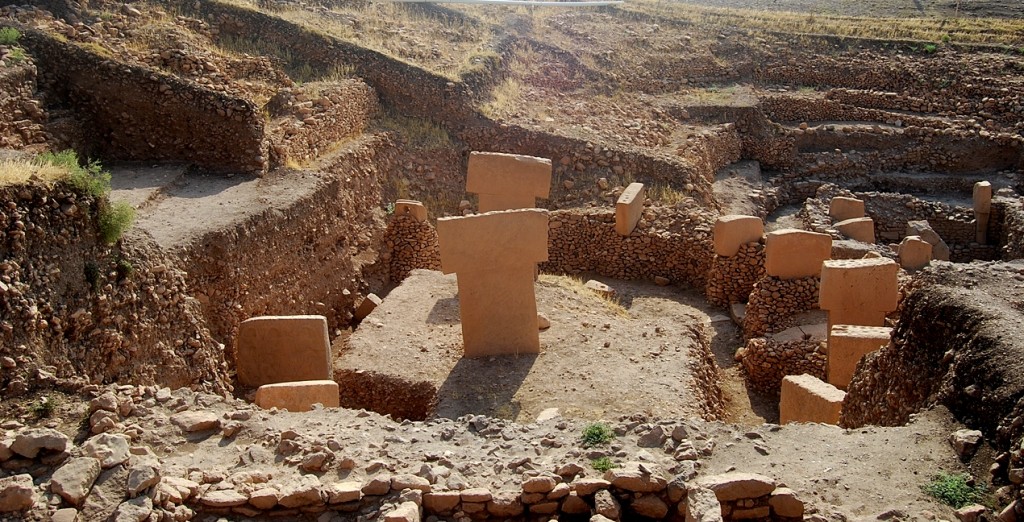
By Ömer Bülent Sever
Göbekli Tepe (“Stomach Hill” in Turkish) is a unique archaeological site, a Stone Age sanctuary beneath massive sediments on a hill at about 750 meters (2460 ft.) above sea level and about 15 kilometers (9.5 miles) northeast of the city of Şanliurfa (Urfa / Edessa) in southeastern Turkey (also long known as the region of Anatolia). Its monolithic stone pillars that stand up to 18 feet hight cannot fail to impress modern viewers, especially since they have only emerged upright from under about six meters of overburden in the last decade or so after being buried about 10,000 years.
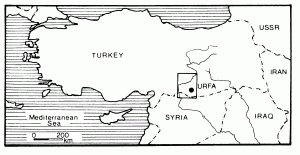
The fact that the complex had remained almost untouched since the Stone Age is partly due to the fact that it is located at relatively high altitude. Dating from the period of the tenth and ninth millennia BCE, it is more than six thousand years older than the prehistoric site of Stonehenge in southern England and remained unexplored until recent digs. It also predates Çatalhöyük, another Turkish Neolithic site by several millennia.
Like numerous Neolithic settlements located in valleys with access to water and the prerequisites for agriculture, Göbekli Tepe dominates the landscape. A stunning panorama presents itself to the visitor from the highest point of the mound where local women frequent the site known as the hill of ritual with its wishing tree. To the west, the city of Şanliurfa is only slightly obstructed by the Germuş Mountains. To the north, if the weather is clear, you are able to see the eastern part of the Taurus mountain range. An old volcano, Karacadağ, looms in the east, and to the south the fertile plain of Harran extends as far as Syria. No doubt, the complex of Göbekli Tepe must have been designed to be a widely visible landmark.
The site was discovered in 1963, when a joint Turkish-American research team (Istanbul University and University of Chicago) conducted a field study in the area but were unable to recognize the real significance of the site. At that time research was not advanced enough to enable an accurate assessment of the discovery. As it seems, nobody associated the archaeological remains with a potential Stone Age ritual site. It was not until 1994 that some of the greater importance of the site was recognized. Since 1995 annual excavations have been carried out directed by the German archaeologist Klaus Schmidt under the auspices of the German Archaeological Institute (DAI), funded by the German Research Foundation (DFG) and initially in cooperation with the Museum of Şanliurfa. [1]
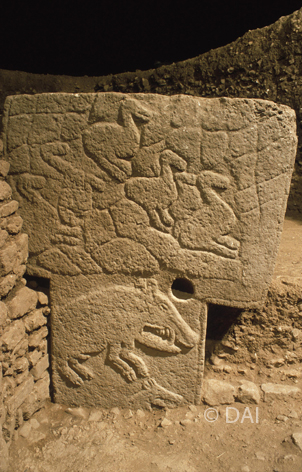
Recently, the full significance of the site’s Neolithic monumentalism has brought it to the fore of the eariest sites in the world. The stone monoliths of the sanctuary have been interpreted by many historians and archaeologists as the oldest surviving temple in the world. The excavation site presents itself as a homogenous ensemble with relics of Stone Age activities (e.g. quarrying), not only to be found at the actual sanctuary, but also in the limestone plateau surrounding the mound. This has inspired plans to create a public archaeological park in the immediate environs of the excavation area and a roof to protect it. Construction work for this project will be carried out simultaneously with the digs.
A brief chronological outline of Göbekli Tepe shows ist great antiquity. Elsewhere, the existence of a Pre Pottery Neolithic (PPN) phase in which pottery was not yet in use (approximately 10,000-6,500 BCE) was revealed by Kathleen Kenyon’s excavations at Tell-es-Sultan (Jericho) in the Jordan River Valley of Palestine. Evidence for such an early Neolithic phase was found in the Middle East and Anatolia has been backed up for the past 40-50 years by valuable in-depth information retrieved from further excavations and other archaeological activities. PPN or Pre-Pottery Neolithic, with which Göbekli Tepe is associated, is commonly sub-classified in phases A (earliest phase), B and, in parts, C. Pre-Pottery Neolithic is followed by the Ceramic Neolithic, a period in which the distinctive neolithic characteristics such as sedentariness, agriculture, animal husbandry and pottery are fully developed.
Tools made of flint and bone, as well as millstone grinders and stone vessels, all of them representative of a PPN (Pre-Pottery Neolithic) site, are the essential finds of the material culture of Göbekli Tepe. Yet, the most noteworthy legacy of Göbekli Tepe is its spectacular stone circles consisting of a set of monolithic T-shaped pillars which measure up to five meters in height. Until a few years ago, excavations focussed primarily on four of the monumental stone circles which have been dated into the tenth millenium BCE. Until now two Stone Age archaeological levels have been uncovered: Stratum III (9,600-8,800 BCE) and Stratum II (8,800-8,000 BCE). Recently digs and other research projects have been extended to the southwestern and northern hills, with unique results.
The determining feature of the older archaeological level, Stratum III, is its T-shaped pillars. Up to five meters in height and weighing tons, they are arranged in circle-like or rather oval shapes around two particularly large central pillars and integrated into walls encompassing the ensemble while shutting it off from its surroundings, thus creating an interior space. All pillars face the two pillars in the center of the circle. It seems obvious that the duality of the central pillars was of special significance. However, it is essential that they be investigated in more detail. The fact that depictions of arms can be seen embracing the pillars suggests that the pillars represent anthropomorphous beings. The upper horizontal element of the T-shape might be interepreted as a head, and the long, vertical element as a body. Enclosures A, B, C, and D are ascribed to this phase.
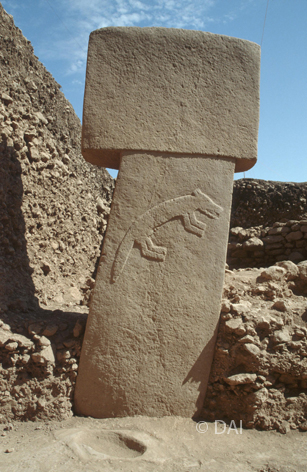
Enclosure C, measuring 30 meters in diameter with its four concentrically arranged wall shells and with an inner diameter of twelve meters, is poorly preserved. The damage on the two central pillars may have been the work of early iconoclasts after digging a large pit. The demolition work done in enclosure C roughly dates, at the latest, to the period after PPN (Pre-Pottery Neolithic). One of the central pillars was recently partly restored and re-erected. In enclosure C, the dominant motif is the wild boars, while foxes prevail on the central pillars. Pillar 27 is carved with a naturalistic representation of a snarling beast of prey with ist distinctive ribs in high relief.
Enclosure D is the best preserved part of the complex. The two central pillars, measuring more than five meters in height, surmount the pillars in the surrounding circle by more than one meter. Here too, the pillars are decorated with bas-reliefs of animal motifs reminescent of the entire livestock of a zoological garden, including wild asses, gazelles, foxes, wild boars, sheep, bulls, vultures, ibises, ducks, cranes, spiders, snakes, and scorpions. While many of the animals are depicted in independant entities, some do interact. In addition, there are two parallel bands in bas-relief on the front sides of several pillars which are interpreted as garments resembling a priestly stole. Other reliefs represent abstract symbols which have been described as “hieroglyphic mythograms” and may be regarded as storage media of the cultural memory of the Stone Age. Whether the represented imagery should be seen as attributes of the respective pillar beings or rather as a coherent sequence of pictures conveying a story, or perhaps a myth, is an unanswered question which requires further research.
All the T-pillars are monolithic, i.e., made from one piece. Some of them, among others the central pillars of enclosure D, have arms and hands carved into the broad sides of their shafts. The cubically reduced shape and the absence of anatomical details seem to carry information yet to be deciphered, and the most recent dig seasons brought to light further interesting and unique symbols on the T-pillars, which are currently under scientific investigation. The more or less naturalistic sculptures of animals and human beings dating from the tenth millenium BCE give ample evidence of the skills humans possessed back then. Were the stone pillars meant to represent their ancestors or other important humans? Did they portend to a gathering of gods or other beings? Whatever they were meant to represent, they must have played an essential role in the events taking place at Göbekli Tepe.
The enclosures also contain large-sized limestone sculptures. In this group, wild and dangerous animals prevail, several of them snarling. Could they have been the guardians of Göbekli Tepe? Not all of the animals depicted can be reliably identified, although none of them shows signs of deviations from the animals known to us. They are protagonists of the stories recorded in the imagery and seem to populate a mythological cosmos. Finds of fauna remains secured at Göbekli Tepe bear testimony to a wide range of wildlife, but have not rendered any evidence of animal domestication so far. Neither do the botanical remains support the existence of domesticated crops.
The younger Stratum II, dated to the middle PPNB (Pre-Pottery Neolithic B period) in the ninth millenium BCE, holds rectangular buildings without doors and windows, measuring four to six meters in length and three to four meters in width. Its pillars are less in number and shorter, compared to previous levels, measuring only 1.5 meters (5 ft.) in height. Here it is mostly the detached pair of central pillars that have outlasted time. The “lion column building” is the outstanding structure of Stratum II, a rectangular complex with reliefs of felines on pillars I and II, possibly lions or leopards, in keeping up with the archaeofauna of the area. Between the “lion columns”, the only representation of a woman so far has been found, a drawing of a crouching female figure, engraved in a stone plate, possibly a bench top. Since no evidence for the cult of the “Great Goddess” has been verified at Göbekli Tepe, the figure has not been interpreted as a representation of the “Great Goddess”, and there is no indication that such a cult existed in the mythological cosmos of the time.
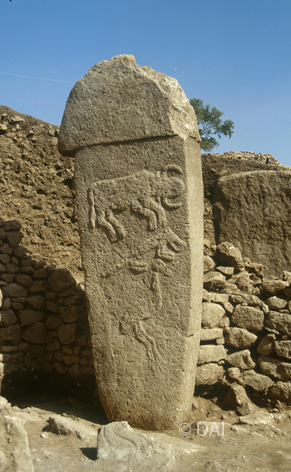
Due to the size of the investigated area, it is only possible to briefly touch on some of the findings and research results in this article. In enclosure E, there is, for example, a “rock temple” which is associated with other monumental ancient complexes, possibly pertaining to a stone circle that had been taken down such that nothing from it has survived.
An area named “the studio” was apparently once used for the production of limestone sculptures. On the plateau further west we find “the quarry” for megalithic stone tool pieces, on the southern plateau the “Roman Watchtower” with traces of architecture from a later period, possibly Roman. A link to the Roman Euphrates-Limes (boundary) is possible.
Geophysical studies showed that Göbekli Tepe holds in Stratum III at least 20 more monumental enclosures and an even larger number of buildings yet to be unearthed. It is important to point out that the mound was created when, still in the Stone Age, the complex was gradually filled or “buried” which resulted in an artificial hill. Whether Göbekli Tepe served as the setting for a wide geographical cult of the dead – possiby for nomadic peoples [2] – remains one of the unanswered questions about the site.
The Stone Age sanctuary of Göbekli Tepe is associated with the performance of ritual practices. While the nature and form of those practices have yet to be clarified, it is undisputable that the monuments provide evidence of a society with a highly advanced organizational structure and astounding community accomplishments of raising stone monuments, which for the time frame in question were unthinkable before the discovery of the site.
Göbekli Tepe was not a location where normal daily life would seem to have taken place. Seemingly only used for cults and rituals, it is unlikely that it was permanently inhabited by a significant number of residents. However, it is assumed that it was perennially attended by some kind of cult staff. No living quarters have been found so far. They might have been situated between units not directly associated with the ritual facilities.
Göbekli Tepe was a phenomenon pertaining to the final phase of the old world of hunters and gatherers, on the eve of the so-called Neolithic Revolution. Around 8,800 BCE, the utilization of the site came to an end in Stratum II and was abandoned. Once buried, itself a long process, the complex sank quickly into oblivion. Since it was not reoccupied, it has for the most part been spared from human activity until its recent discovery. It surely possesses a great many secrets waiting to be revealed. One of the most interesting recent theories is that the very urge to worship may have sparked institutional religion itself in such places as Göbekli Tepe. [3]
Ömer Bülent Sever, author of the article, is a lawyer from Istanbul who in his thirties decided to take up the study of archaeology in Erlangen, Germany. He has had the pleasure to participate in several excavation campaigns at Göbekli Tepe directed by Klaus Schmidt.
[1] Klaus Schmidt. “Göbekli Tepe, Southeastern Turkey. A preliminary Report on the 1995–1999 Excavations”, Paris: CNRS, Paelorient 26.1 (2000) 45-54.
[2] Sandra Scham. “The World’s First Temple.” Archaeology Magazine. (Nov/Dec, 2008) 23 & ff.
[3] Charles Mann. “The Birth of Religion: The World’s First Temple,” National Geographic 219.6 (June 2011) 39 & ff.